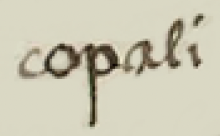copalli (CST24)
This painting of the simplex glyph for the term copalli castilla (often written as Caxtillan, and here, referring to Spanish incense) shows a bowl on a pedestal. It is overfilled with three layers of small circles above the rim. A spoon or ladle with a handle emerges from the bowl on the viewer’s right.
Stephanie Wood
The companion text describes this incense as Spanish, and the container also appears to be a colonial innovation. For another glyph of copalli, seemingly cupped in a leaf wrapper, see below. A stick of incense (iyetl) is also a part of this glyph collection. For more on the Codex Sierra, see Kevin Terraciano’s study (2021), especially pp. 116 and 150, for the transcription and translation of this passage.
Stephanie Wood
1550–1564
Jeff Haskett-Wood
incienso, recipiente, cuenco, tazón

copal(li), incense, copal, https://nahuatl.wired-humanities.org/content/copalli
Caxtillan, Castile or Spain, https://nahuatl.wired-humanities.org/content/caxtillan
copal
Stephanie Wood
Códice Sierra-Texupan, plate 24, page dated 1559. Origin: Santa Catalina Texupan, Mixteca Alta, State of Oaxaca. Kevin Terraciano has published an outstanding study of this manuscript (Codex Sierra, 2021), and in his book he refers to alphabetic and “pictorial” writing, not hieroglyphic writing. We are still counting some of the imagery from this source as hieroglyphic writing, but we are also including examples of “iconography” where the images verge on European style illustrations or scenes showing activities. We have this iconography category so that such images can be fruitfully compared with hieroglyphs. Hieroglyphic writing was evolving as a result of the influence of European illustrations, and even alphabetic writing impacted it.
https://bidilaf.buap.mx/objeto.xql?id=48281&busqueda=Texupan&action=search
The Biblioteca Digital Lafragua of the Biblioteca Histórica José María Lafragua in Puebla, Mexico, publishes this Códice Sierra-Texupan, 1550–1564 (62pp., 30.7 x 21.8 cm.), referring to it as being in the “Public Domain.” This image is published here under a Creative Commons license, asking that you cite the Biblioteca Digital Lafragua and this Visual Lexicon of Aztec Hieroglyphs.


